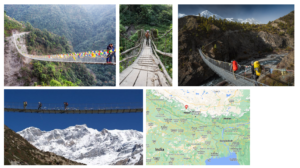In 1995, Clint Eastwood romanced Meryl Streep in a film called The Bridges of Madison County. The movie was okay; I hear the book was better. But as I’m watching the film, I can’t help thinking, “I came for the bridges? Where are all the bridges? Shouldn’t there be a big sign saying, “Welcome to Madison County” and just past it, a big honkin’ bridge? At least they could have a dentist showing his patients’ dental bridges, right? Or how about casting actor brothers Jeff and Beau Bridges? That would be something!
I can tell you right now that if I ever make a movie about my Annapurna trek, I’ll call it “The Bridges of Nepal,” and there WILL be bridges. Because there are a LOT of bridges in Nepal, and they’re all completely insane: long, high, precarious, with gaps in the floor slats covered with rocks to “make it safe”. There’s this one bridge, on the way to Kagbeni, that is particularly bonkers. Spanning a river hundreds of feet below, the bridge is long and narrow, with room for one, maybe two hikers at a time. But this is the Himalayas, where everything is multi-use at all times. As my 3 Australian friends and I start across the bridge, one at a time, bulky backpacks on our shoulders, a Nepalese guy on the other side decides this is the perfect moment to send his oxen across. There we are, in the middle of the bridge, waving our arms and motioning, “Please, no, stop!” – to no avail – and here come the oxen, with their “shepherd” whipping their behinds to keep the beasts moving, right towards us! This is one of those moments when you have to make a split-second decision with your life in the balance. Should we turn around and run back to the other side as fast as we can? Or should we hunker down in the middle of the bridge and “make our stand”? As it turns out, there’s not really time for the first option, so we go with plan B. Julia just sits down. Jim, Steve and I turn our packs to the side, lean against the cables, hoping the steer will have room to squeeze by. As the pack gets closer and closer, my life flashes through my eyes. I can almost see the headlines: “Foreign backpackers fall to their death in the Himalayas. Oxen herder delivers his flock successfully.”

Obviously, I’m here, in front of my computer, writing this post, so I I survived somehow. It was a close call, though. The oxen stomp up to us and, miraculously, keep on walking, as if we’re just flies to be ignored (and not swatted away, thankfully). A minute later, the creatures are all past us and my friends and I burst out in laughter: the laughter of both relief and absurdity. Did this really happen? Are we really hiking in Nepal, 10,000 miles from home, near the top of the world, and trusting our lives to the temperament of oxen? We make it to the other side eventually, breathe a giant sigh, and continue on the trail until we reach a portion that has been wiped out by a landslide. Into the scree someone has sketched out a little dirt trail, with no handrails or guidewires in sight. One misstep and we’re sliding all the way down the mountain. But that, dear readers, is a story for another day.
(Trust is a tricky thing. When it comes to people, we rely on our instinct and observational skills to determine if this or that fellow is “trustworthy.” Does he do what he says he’s going to do? Does he lie? Is he competent? Is he kind? But when it comes to crazy, spontaneous situations like an oxen bridge in Nepal, you just have to trust your gut. Does this feel safe? Do I trust my judgment? Do I have the ability to respond to whatever comes at me in the moment? In such cases, there are no guidelines, no manuals. You just have to draw on your experience and trust that if you made good decisions in the past, you’ll probably make the right decision now. The more successes you have, the more you’ll trust yourself going forward. Let experience be your bridge to the future.)
